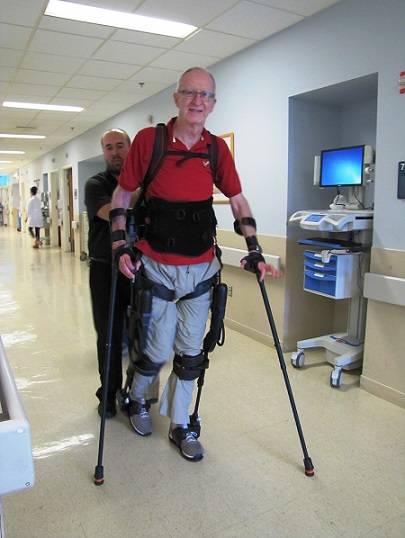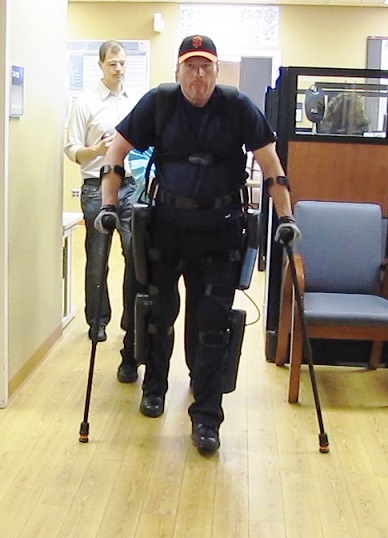Spinal Cord Injury
A Randomized, Crossover Clinical Trial of Exoskeletal-Assisted Walking to Improve Mobility, Bowel Function and Cardio-Metabolic Profiles in Persons with SCI



Posted December 19, 2017
Ann M. Spungen, Ed.D., Bronx Veterans Medical Research Foundation, Inc.

Ann M. Spungen, Ed.D., Bronx Veterans Medical Research Foundation, Inc.

Peter Gorman, M.D., University of Maryland

Gail Forrest, Ph.D, Kessler Foundation
Spinal cord injury (SCI) is a severe neurotraumatic event that negatively impacts spinal cord function. Physical activity is dramatically reduced after SCI, leading to many changes in the body, including loss of muscle mass, gain of fat tissue, reduced physical fitness, chronic nerve pain, increased risk of cardiovascular disease, and bladder and bowel dysfunction.
Research by Dr. Ann Spungen and her colleagues at the University of Maryland, Dr. Peter Gorman, and the Kessler Foundation, Dr. Gail Forrest, focuses on the benefits of using an exoskeletal-assisted walking device to improve quality of life for SCI patients. Recent technological advances have made it possible for persons with lower extremity paralysis to stand and walk upright again. Dr. Spungen received a fiscal year 2013 (FY13) Clinical Trial Award from the Spinal Cord Injury Research Program (SCIRP) to evaluate the functional gains achieved after using these devices for an extended period of time. A preliminary study with 10 SCI patients demonstrated that the participants were able to successfully walk using the assistive device for 4 to 6 hours per week over a 3-month period. With the FY13 award, Dr. Spungen is expanding her previous study to assess walking proficiency, as well as improvements in bowel function and body composition, in study participants at three test centers. By allowing SCI patients to increase their level of physical activity, exoskeletal-assisted walking devices could help improve blood cholesterol profiles, cardiovascular function, sex hormone activity, and the body's sensitivity to insulin, all of which could lead to favorable changes in metabolism, muscle and fat, and result in a better quality of life.
Dr. Spungen and her colleagues plan to study 64 volunteers over a 4-year period across the participating research centers: James J. Peters VA Medical Center, Bronx, NY; Kessler Foundation Research Center, West Orange, NJ; and the University of Maryland Rehabilitation and Orthopaedic Institute in Baltimore, MD. All participants use a wheelchair for community mobility. Half of the study participants will first be enrolled in exoskeletal-assisted walking training three times per week for 12 weeks, while the other volunteers will be observed performing their usual activities for the same period. After 12 weeks, the groups will crossover. At the beginning, middle and end of the study, Dr. Spungen and her colleagues will assess walking ability, bowel function, and body composition. They will also gather data concerning the retention of walking abilities and the effects of walking on orthostatic tolerance, lipid profile, total testosterone, estradiol levels, and overall quality of life.
The information gained from Dr. Spungen's clinical trial will shed more light on the potential health benefits of exoskeletal-assisted walking by providing persons with SCI with a means to walk again and has the potential to advance treatment and caregiving approaches for these assistive devices.

US Marine Corps Veteran William Lehman - walking with the help of the Ekso exoskeleton

US Air Force Veteran Daniel Grady - walking with the help of the Rewalk exoskeleton
Link:














